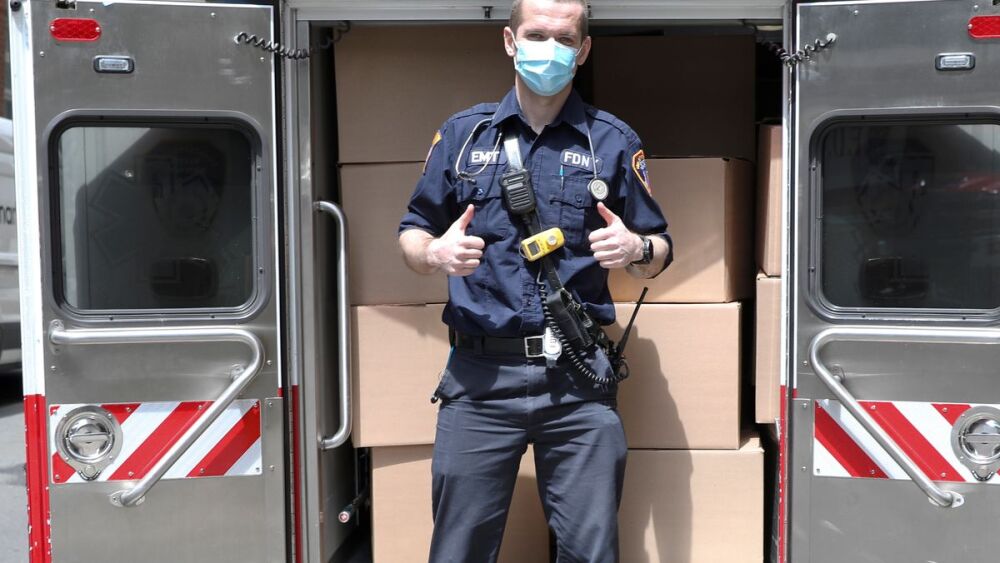In the war on COVID-19, EMS has joined hospital workers, public health departments and other vital healthcare system workers in identifying and caring for potentially infected individuals to ensure they receive lifesaving care and lessen the community-wide health impact of the pandemic.
Caring for critical cases on a large scale – such as after train derailments, airplane crashes or mass shootings – is not something EMTs, paramedics and firefighters are unfamiliar with. What’s different about COVID-19 is the nature of the event. It’s not a short battle; it is a war with an unseen enemy.
Not only are EMTs, paramedics and firefighters standing alongside nurses and doctors to fight, but in some ways, the battle continues off duty, too. Like other frontline healthcare workers, EMS and fire personnel go home and remove a uniform (scrubs or white coats) and then may be called on to provide a similar caretaking role once at home.
Cities and states around the country are beginning to open up – talking heads on TV debate whether it’s too early or that we’re late enough already. At the same time, the threat of a second wave seems real – and some say inevitable. Healthcare workers continue to operate in unknown territory that may pose a threat to their mental health and test their resiliency.
Entering a new normal
Large-scale pandemics, particularly one such as COVID-19, with its pronounced domestic impact, may be new territory in the U.S., but they aren’t without precedent in other parts of the world. An unprecedented SARS outbreak occurred in 2003 affecting many countries, including China, Taiwan, Singapore and Canada. Like COVID-19, the SARS outbreak was caused by a coronavirus and there were many unknown factors regarding its transmission and symptoms.
Although not as widespread or long-lasting as the COVID-19 pandemic, studies of the psychological effects of SARS may help to predict what our “new normal” will look like and help to ensure readiness for a potential second wave of COVID-19 infection.
Assess altruistic risk acceptance
Symptoms of post-traumatic stress (PTS), such as lingering anxiety and depression, may be experienced by a significant portion of the general population. Healthcare workers at high risk of exposure to confirmed COVID-19 patients may be more vulnerable to depressive symptoms but may also be protected from possessing altruistic acceptance of this risk.
With the 2003 SARS outbreak, roughly 12% of the population of Taiwan were estimated to have experienced some psychiatric morbidity, and, in Singapore, a community-based sample reported that nearly 25% of all respondents had PTSD symptoms [1,2].
During the SARS outbreak, healthcare professionals continued to work through this period of uncertainty and ever-changing circumstances. A study from Toronto, estimated that a high degree of distress was experienced by 29-35% of healthcare workers [3]. Although outbreak-related PTSD symptoms were associated with perceived SARS risk in studies of healthcare workers conducted within a year of the SARS pandemic, a 2-year post-pandemic study from Toronto showed that healthcare workers saw lower incidence rates of new episodes of major depression and new-onset PTSD versus the general population [4]. A cross-sectional study of healthcare workers in China 3 years after SARS found that reported altruistic acceptance of SARS risk was a mitigating factor, significantly decreasing the odds of developing depressive symptoms [5].
EMTs, paramedics and firefighters generally understand the risks associated with the job. It takes a special type of person to care for others. As states relax stay-at-home orders and we have some time to take a collective breath, it’s a good time for self-reflection and career-focused meditation. Ask yourself: Given the past several weeks, despite being exhausted like your colleagues, family and friends, are you satisfied with the job? It might not be an easy question to answer, but it’s important to give yourself quiet time to think things through. Understanding why you do what you do every day and recommitting to it – or finding something else – will help build resiliency.
The general public has recognized the significant contributions and sacrifices made by all healthcare sector workers, including EMS agencies and fire departments. During EMS Week – and beyond – be visible in your community and show that you’re proud of the work you do.
Be aware of risk factors
There are several risk factors that may increase a person’s vulnerability to PTSD or depressive symptoms following the COVID-19 outbreak. These may include:
- Being quarantined in isolation from family and friends
- Being stigmatized because of a COVID-19 diagnosis or because of high-risk exposure to COVID-19 patients
- Being diagnosed with and recovering from COVID-19
- Experiencing pre-COVID-19 trauma
Studies of healthcare workers affected by the SARS outbreaks found quarantining in isolation from family (e.g., being quarantined with other workers vs. staying at home with family) and being stigmatized for having to quarantine by people who saw them as more likely to spread the disease, were predictive of subsequent psychologic distress [5]. Furthermore, although prior traumatic experiences are usually strongly predictive of developing PTSD, in the case of the SARS outbreak, researchers found that pre-SARS trauma was actually a predictor that a person might suffer from depressive symptoms [5].
These risk factors applied to SARS and may also apply to COVID-19. It’s important to note that there isn’t yet any data from the current outbreak, so these are evidence-based assumptions only. There may be others or some of these may not apply. Until we have data specific to this outbreak, use these risk factors as a guide. This pandemic isn’t over yet and there may be another wave.
Those at higher risk should:
- Review recommendations for reducing stress levels
- Understand how to manage fatigue
- Check in with friends and colleagues with these risk factors, or if you sense that someone is in need – connecting with one another can help make things easier for both of you
Practice healthy coping
Symptoms of COVID-19-related PTSD, depression and anxiety may lead to maladaptive means of coping, such as alcohol or illicit drug use.
A study measuring the 3-year psychological impact of the 2003 SARS outbreak on healthcare workers found a significant association between levels of post-traumatic stress (PTS) symptoms and the incidence of alcohol abuse/dependence symptoms [6]. Having been quarantined, having worked in a high-risk location and having had family members or friends developing or dying from SARS was associated with higher PTS symptoms [6].
As the curve flattens and our communities relax into a new normal, we must all remember that we are in this together. Everyone’s mental health resiliency is being tested with this pandemic; if you need help moving forward, don’t hold back or reach for alcohol or drugs – reach out.
Read next: Self-care is critical for managing stress levels in EMTs and paramedics responding to COVID-19
References
- Peng EY, Lee MB, Tsai ST, et al. Population-based post-crisis psychological distress: An example from the SARS outbreak in Taiwan. J Formos Med Assoc. 2010;109(7):524‐532.
- Sim K, Huak Chan Y, Chong PN, Chua HC, Wen Soon S. Psychosocial and coping responses within the community health care setting towards a national outbreak of an infectious disease. J Psychosom Res. 2010;68(2):195‐202.
- Maunder R. The experience of the 2003 SARS outbreak as a traumatic stress among frontline healthcare workers in Toronto: Lessons learned. Philos Trans R Soc Lond B Biol Sci. 2004;359(1447):1117‐1125.
- Lancee WJ, Maunder RG, Goldbloom DS; Coauthors for the Impact of SARS Study. Prevalence of psychiatric disorders among Toronto hospital workers one to two years after the SARS outbreak. Psychiatr Serv. 2008;59(1):91‐95. doi:10.1176/ps.2008.59.1.91
- Liu X, Kakade M, Fuller CJ, et al. Depression after exposure to stressful events: lessons learned from the severe acute respiratory syndrome epidemic. Compr Psychiatry. 2012;53(1):15‐23.
- Wu P, Liu X, Fang Y, et al. Alcohol abuse/dependence symptoms among hospital employees exposed to a SARS outbreak. Alcohol Alcohol. 2008;43(6):706‐712.













